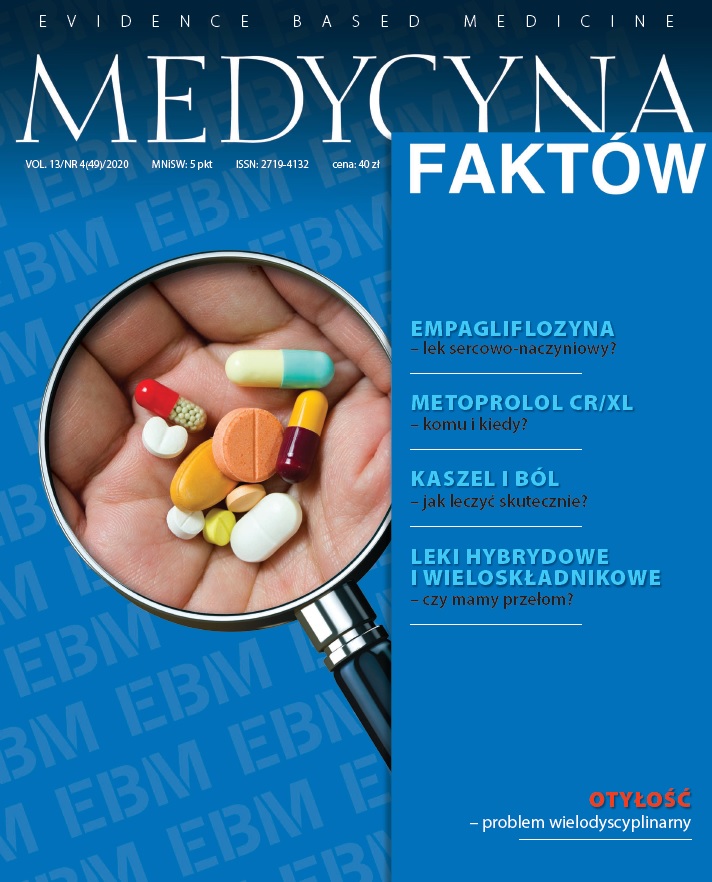Long-term clinical use of mirabegron in patients with overactive bladder syndrome Review article
Main Article Content
Abstract
Overactive bladder syndrome (OAB) is defined by the International Continence Society (ICS) as urinary urgency with increased daytime frequency and nocturia in the absence of proven infection or any other pathology, usually with or without urgency incontinence. Pharmacotherapy with antimuscarinic drugs is highly effective, but more than 60% of patients discontinue the treatment. Development of mirabegron, a β3-adrenoceptor agonist (β3-AR), has become an expected pharmacotherapy option for the non-invasive treatment of overactive bladder. The available studies show that long-term treatment with 50 mg mirabegron in patients with OAB is associated with reducing the severity of symptoms. Data from clinical trials show that mirabegron provides efficacy similar to antimuscarinic drugs, but with a better tolerance profile.
Article Details
Copyright © by Medical Education. All rights reserved.
References
2. Drake MJ. Do we need a new definition of the overactive bladder syndrome? ICI-RS 2013. Neurourol Urodyn. 2014; 33(5): 622-4.
3. Chapple CR, Dvorak V, Radziszewski P et al. A phase II dose-ranging study of mirabegron in patients with overactive bladder. Int Urogynecol J. 2013; 24(9): 1447-58.
4. Lucas MG, Bosch RJL, Burkhard FC et al. EAU Guidelines on Assessment and Nonsurgical Management of Urinary Incontinence. Eur Urol. 2012; 62(6): 1130-42.
5. Abrams P, Andersson KE. Muscarinic receptor antagonists for overactive bladder. BJU Int. 2007; 100(5): 987-1006.
6. Apostolidis A. Antimuscarinics in the treatment of OAB: is there a first-line and a second-line choice? Curr Drug Targets. 2015; 16(11): 1187-97.
7. Maman K, Aballea S, Nazir J et al. Comparative efficacy and safety of medical treatments for the management of overactive bladder: a systematic literature review and mixed treatment comparison. Eur Urol. 2014; 65(4): 755-65.
8. Palmer CJ, Choi JM. Pathophysiology of overactive bladder: current understanding. Curr Bladder Dysfunct Rep. 2017; 12(1): 74-9.
9. Moro C, Tajouri L, Chess-Williams R. Adrenoceptor function and expression in bladder urothelium and lamina propria. Urology. 2013; 81(1): 211.e1-7.
10. Murakami S, Chapple CR, Akino H et al. The role of the urothelium in mediating bladder responses to isoprenaline. BJU Int. 2007; 99(3): 669-73.
11. Lee J, Moy S, Meijer J et al. Role of cytochrome p450 isoenzymes 3A and 2D6 in the in vivo metabolism of mirabegron, a β3-adrenoceptor agonist. Clin Drug Invest. 2013; 33(6): 429-40.
12. Dickinson J, Lewand M, Sawamoto T et al. Effect of renal or hepatic impairment on the pharmacokinetics of mirabegron. Clin Drug Invest. 2013; 33(1): 11-23.
13. Chapple CR, Kaplan SA, Mitcheson D et al. Randomized double-blind, active-controlled phase 3 study to assess 12-month safety and efficacy of mirabegron, a β3-adrenoceptor agonist, in overactive bladder. Eur Urol. 2013; 63(2): 296-305.
14. Chapple C, Amarenco G, López Aramburu MA et al. A proof-of-concept study: mirabegron, a new therapy for overactive bladder. Neurourol Urodyn. 2013; 32(8): 1116-22.
15. Nitti VW, Rosenberg S, Mitcheson DH et al. Urodynamics and safety of the β3-adrenoceptor agonist mirabegron in males with lower urinary tract symptoms and bladder outlet obstruction. J Urol. 2013; 190(4): 1320-7.
16. Nitti VW, Khullar V, van Kerrebroeck P et al. Mirabegron for the treatment of overactive bladder: a prespecified pooled efficacy analysis and pooled safety analysis of three randomised, double-blind, placebo-controlled, phase III studies. Int J Clin Pract. 2013; 67(7): 619-32.
17. Novack GD, Lewis RA, Vogel R et al. Randomized, double-masked, placebo-controlled study to assess the ocular safety of mirabegron in healthy volunteers. J Ocul Pharmacol Ther. 2013; 29(7): 674-80.
18. Abrams P, Artibani W, Gajewski JB et al. Assessment of treatment outcomes in patients with overactive bladder: importance of objective and subjective measures. Urology. 2006; 68(2 suppl): 17-28.
19. Foley S, Choudhury N, Huang M et al. Quality of life in patients aged 65 years and older with overactive bladder treated with mirabegron across eight European countries: Secondary analysis of BELIEVE. Int J Urol. 2019; 26(9): 890-6.
20. Gray SL, Anderson ML, Dublin S et al. Cumulative use of strong anticholinergics and incident dementia: a prospective cohort study. JAMA Intern Med. 2015; 175(3): 401-7.
21. Chapple CR, Nazir J, Hakimi Z et al. Persistence and adherence with mirabegron versus antimuscarinic agents in patients with overactive bladder: a retrospective observational study in UK clinical practice. Eur Urol. 2017; 72(3): 389-99.
22. Yeowell G, Smith P, Nazir J et al. Real-world persistence and adherence to oral antimuscarinics and mirabegron in patients with overactive bladder (OAB): a systematic literature review. BMJ Open. 2018; 8(11): e021889.
23. Wagg A, Franks B, Ramos B et al. Persistence and adherence with the new beta-3 receptor agonist, mirabegron, versus antimuscarinics in overactive bladder: early experience in Canada. Can Urol Assoc J. 2015; 9(9-19): 343-50.
24. Yamanishi Y, Yamanishi T, Tajima H et al. Mirabegron or tolterodine for the treatment of overactive bladder in Japan: which drug is more cos-effective as the first-line treatment? Int J Urol. 2018; 25(10): 863-70.
25. Murray B, Hessami SH, Gultyaev D et al. Cost effectiveness of overactive bladder treatments: from the US payer perspective. J Comp Eff Res. 2019; 8(1): 61-71.
26. Castro-Diaz D, Chapple CR, Hakimi Z et al. The effect of mirabegron on patient-related out- comes in patients with overactive bladder: the results of post hoc correlation and responder analysis using pooled data from three randomized phase III trials. Qual Life Res. 2015; 24(7): 1719-27.

